Abstract
Increased esophageal acid exposure in gastroesophageal reflux disease has several potential causes, some related primarily to physiological dysfunction of the LES and others related to anatomic distortion of the gastroesophageal junction as occurs with hiatus hernia. One attractive feature of implicating hiatal hernias in the pathogenesis of reflux disease is that, like reflux disease, axial hernias become more common with age and obesity. However, the importance of hiatus hernia is obscured by imprecise definition and an all-or-none conceptualization that has led to wide variation in estimates of prevalence among normal or diseased populations. There are at least three potentially significant radiographic features of a hiatus hernia: axial length during distention, axial length at rest, and competence of the diaphragmatic hiatus. Although any or all of these features may be abnormal in a particular instance of hiatus hernia, each is of different functional significance. Grouping all abnormalities of the gastroesophageal junction as "hiatus hernia" without detailing the specifics of each case defies logic. Mechanistically, the gastroesophageal junction must protect against reflux both in static and dynamic conditions. During abrupt increases in intra-abdominal pressure, the crural diaphragm normally serves as a "second sphincter," and this mechanism is substantially impaired in individuals with a gaping hiatus. Large, non-reducing hernias also impair the process of esophageal emptying, thereby prolonging acid clearance time following a reflux event (especially while in the supine posture). These anatomically-determined functional impairments of the gastroesophageal junction lead to increased esophageal acid exposure. Thus, although hiatus hernia may or may not be an initiating factor at the inception of reflux disease, it clearly can act as a sustaining factor accounting for the frequently observed chronicity of the disease.
Full text
PDF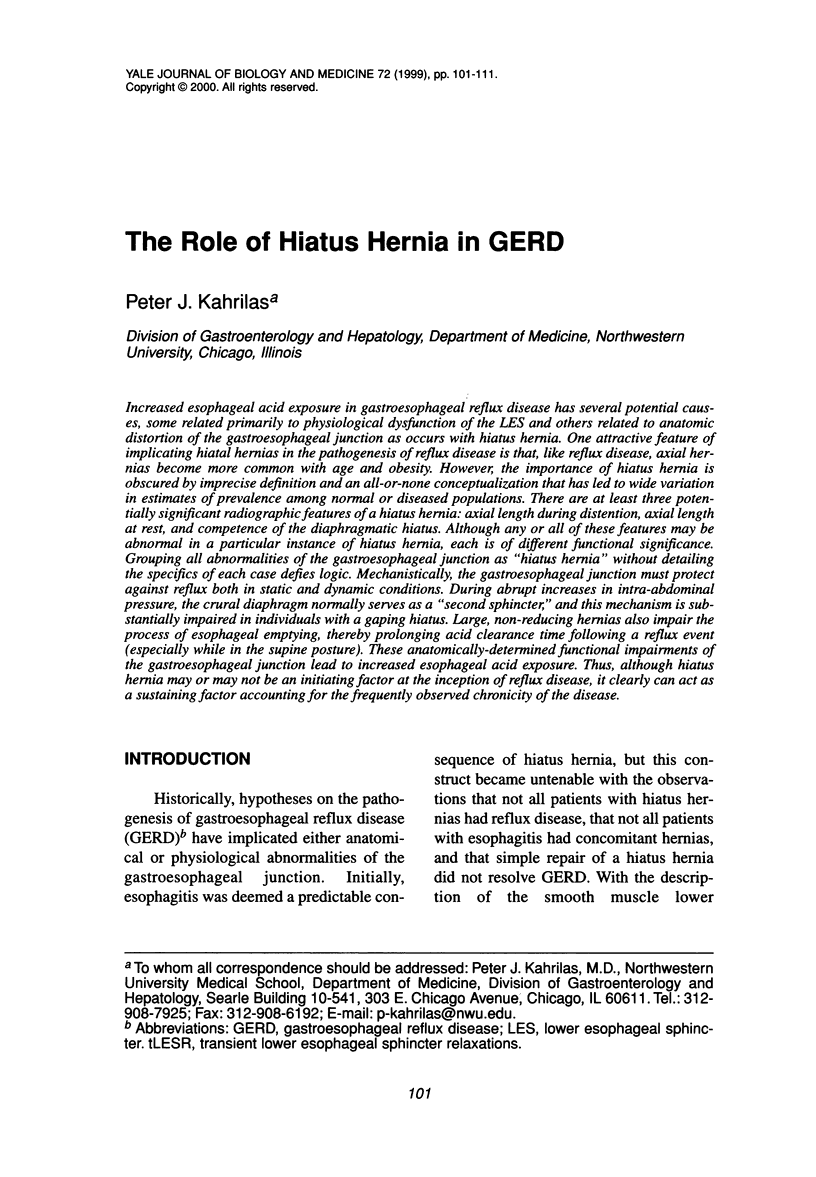
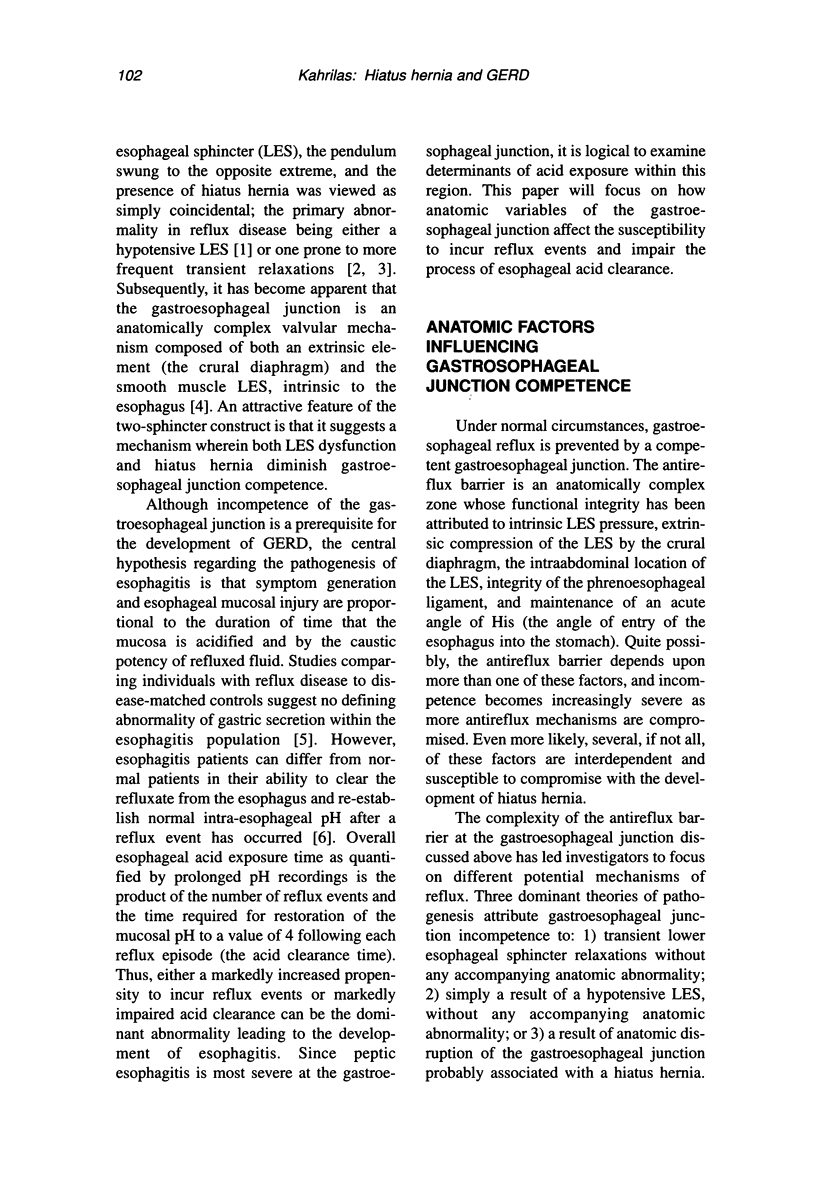
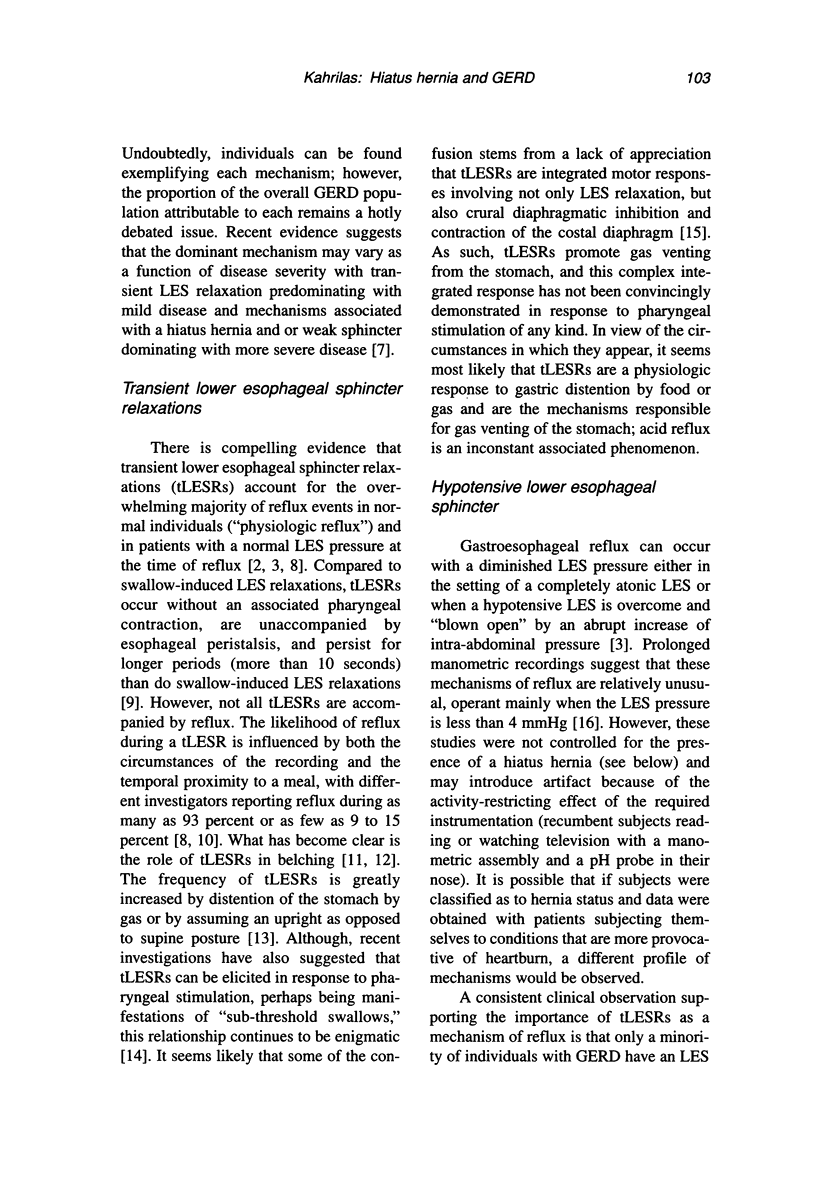
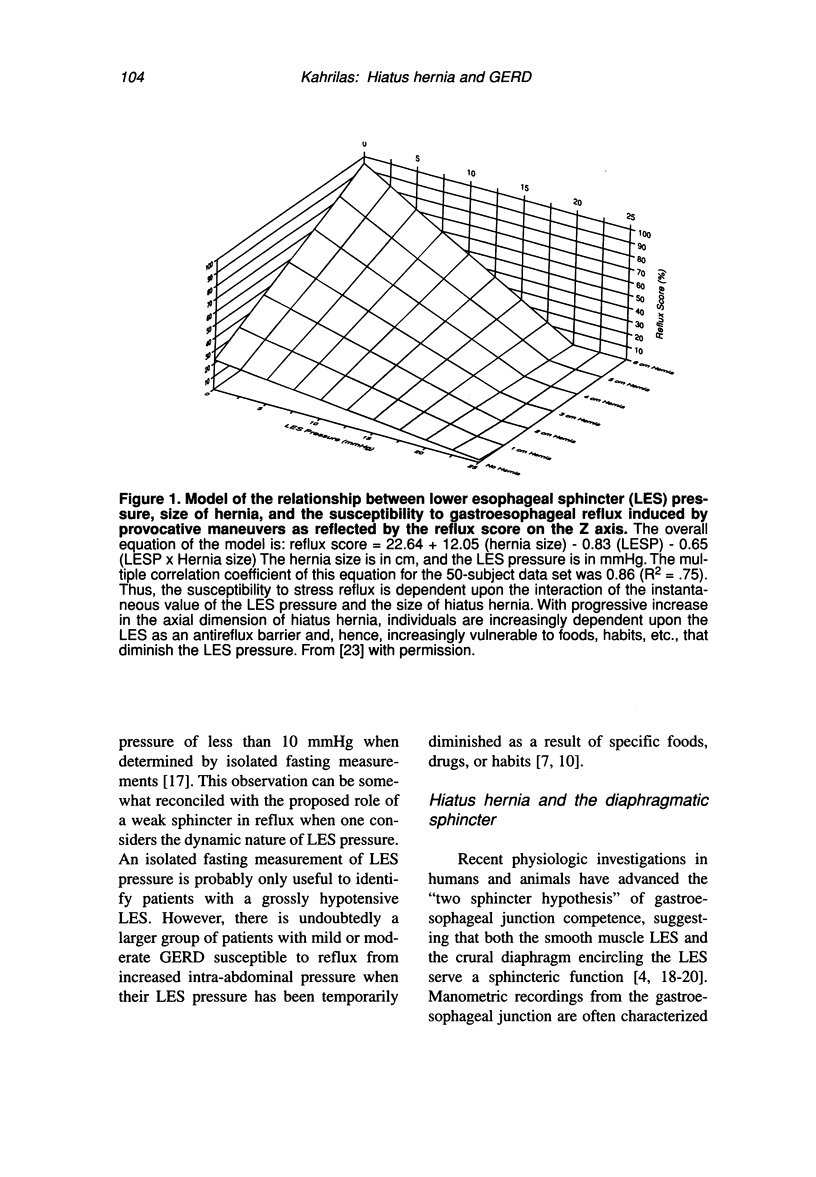
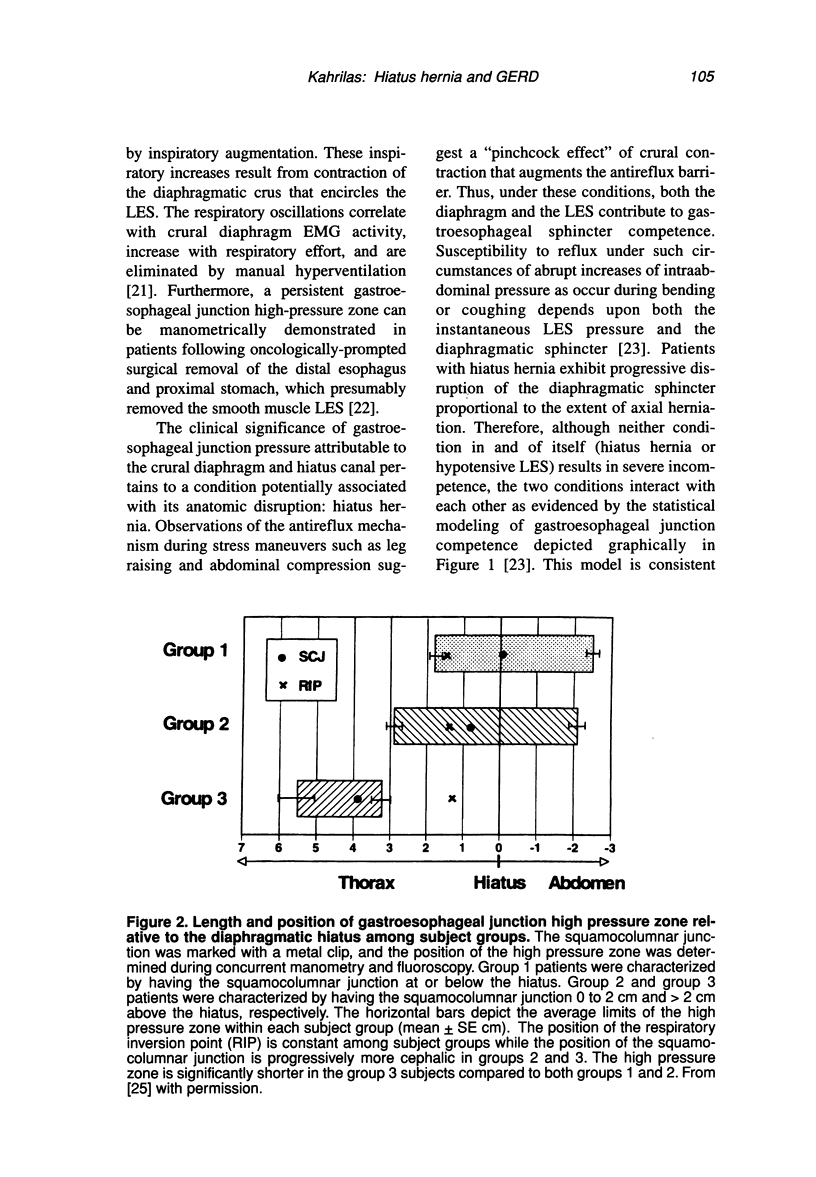
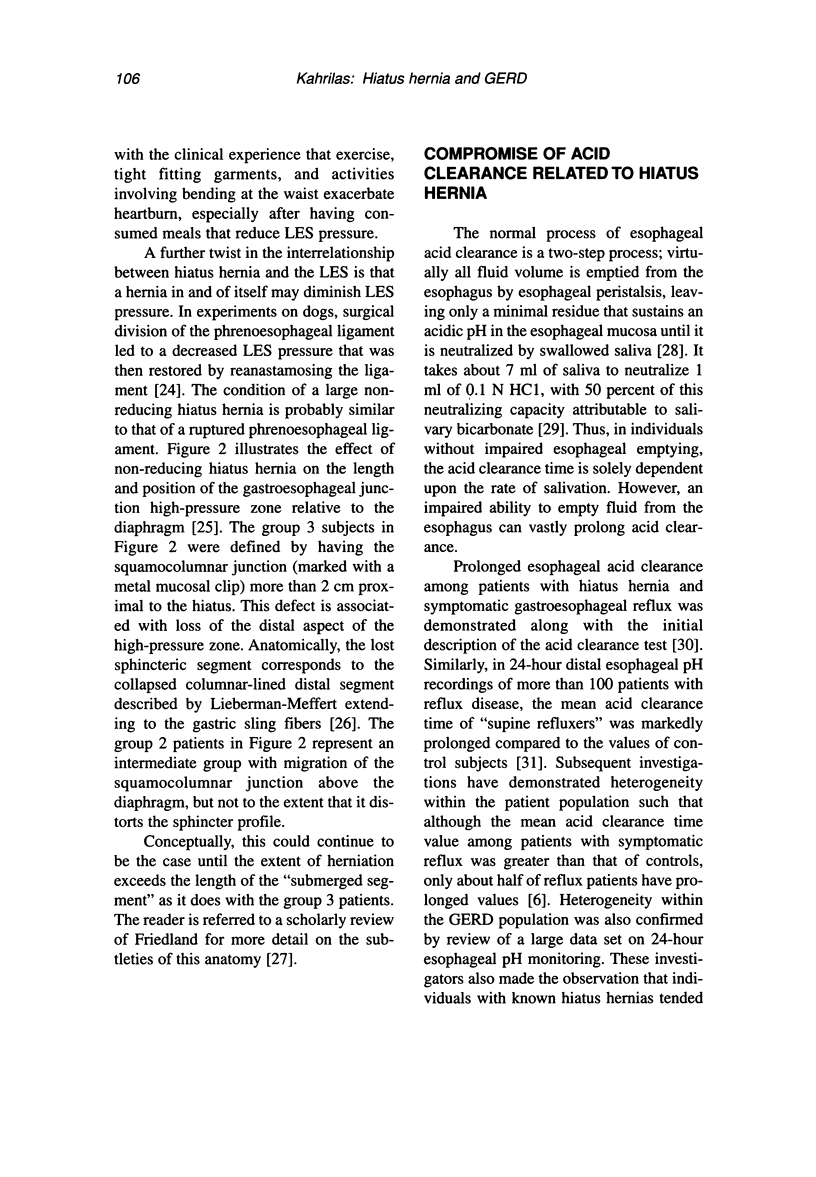
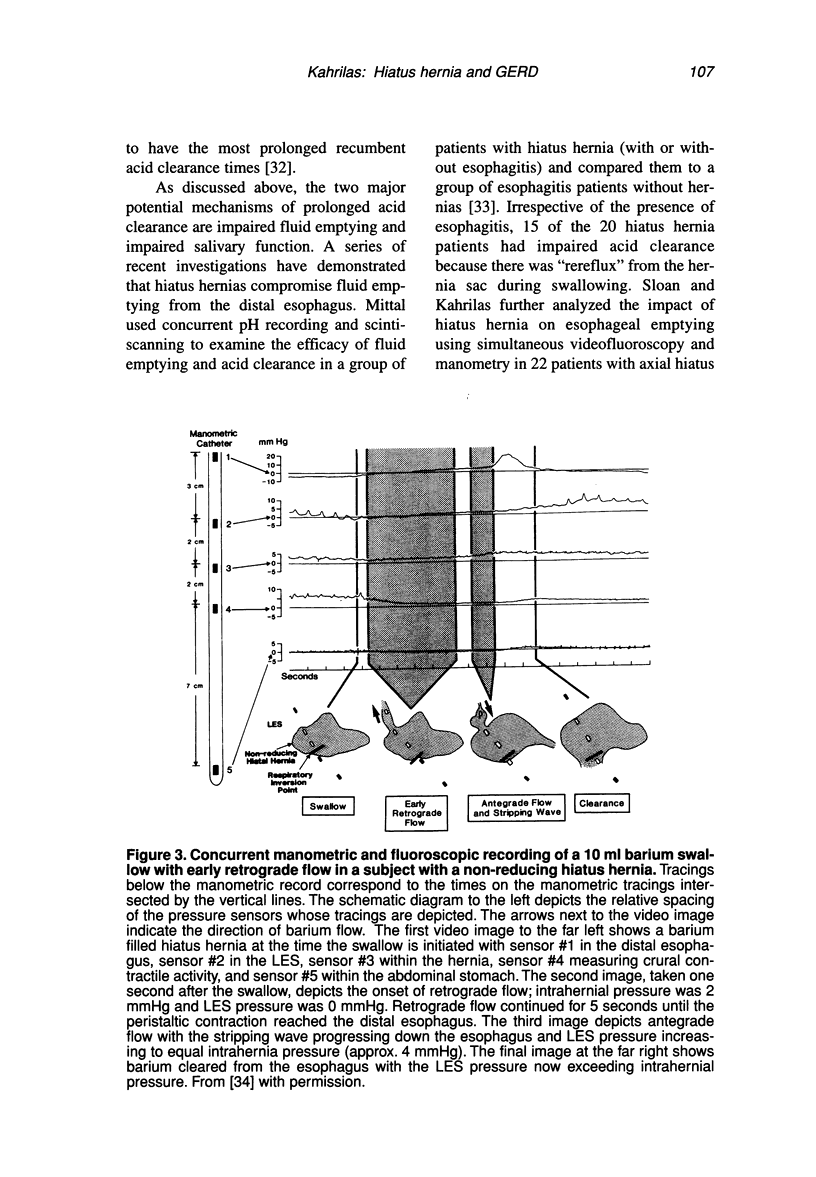
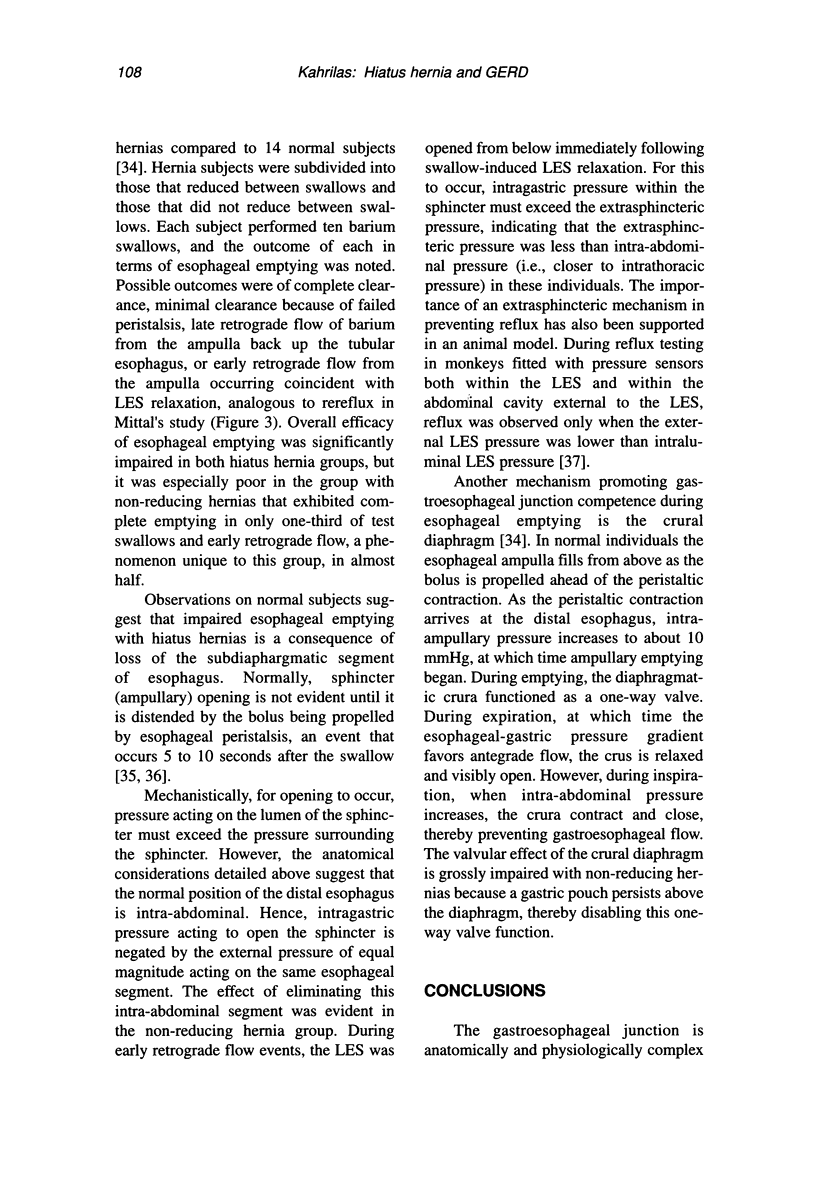
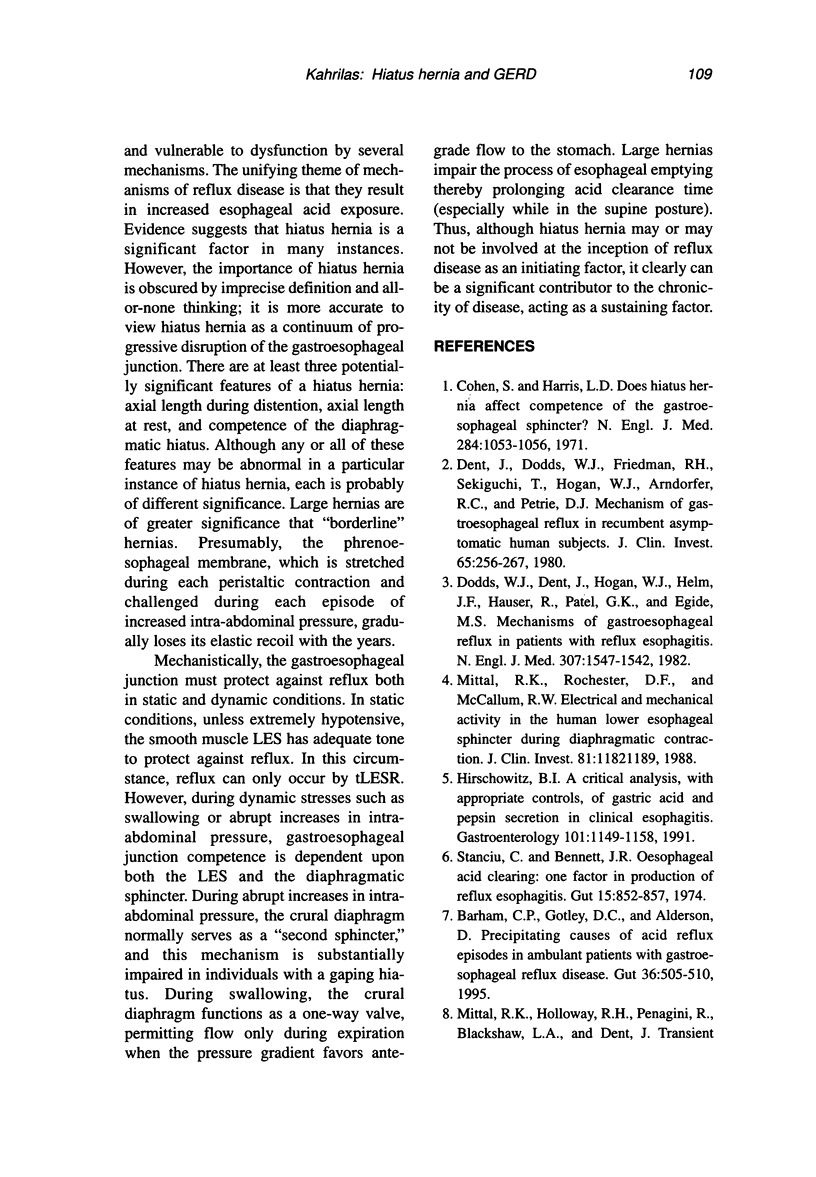
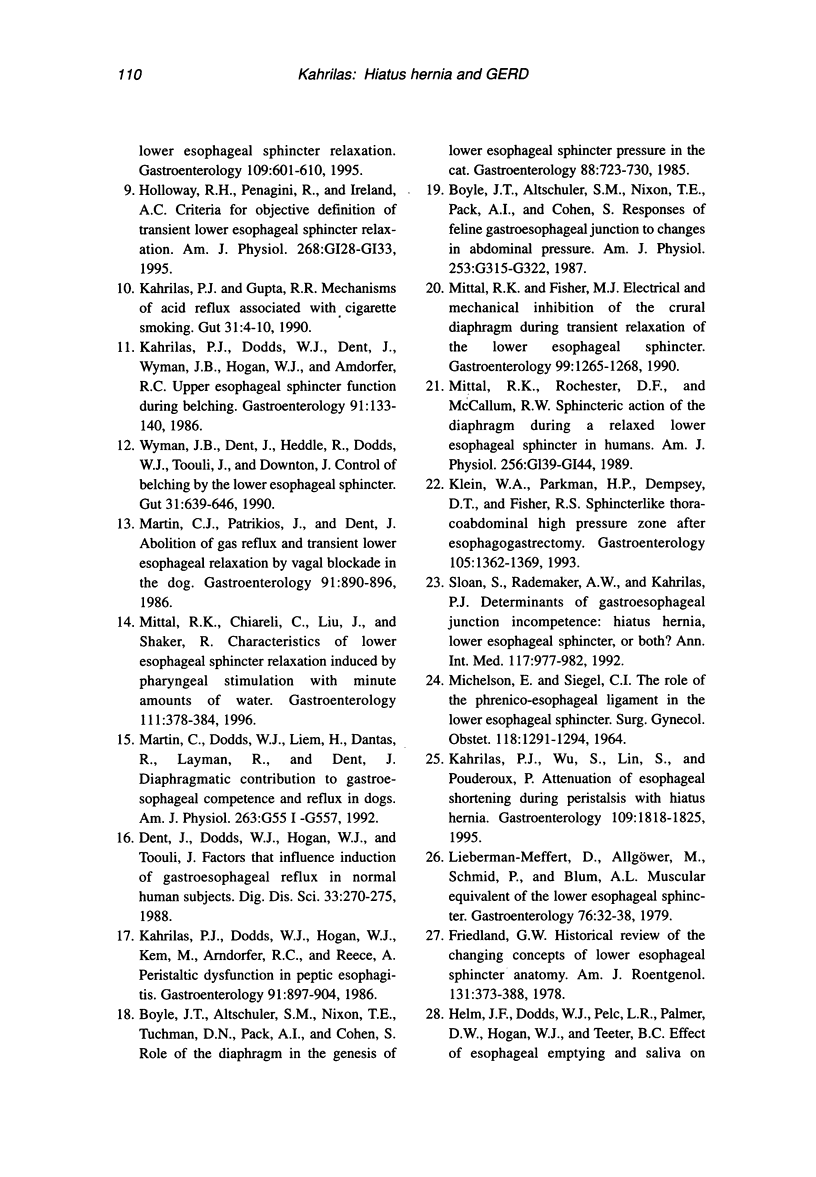
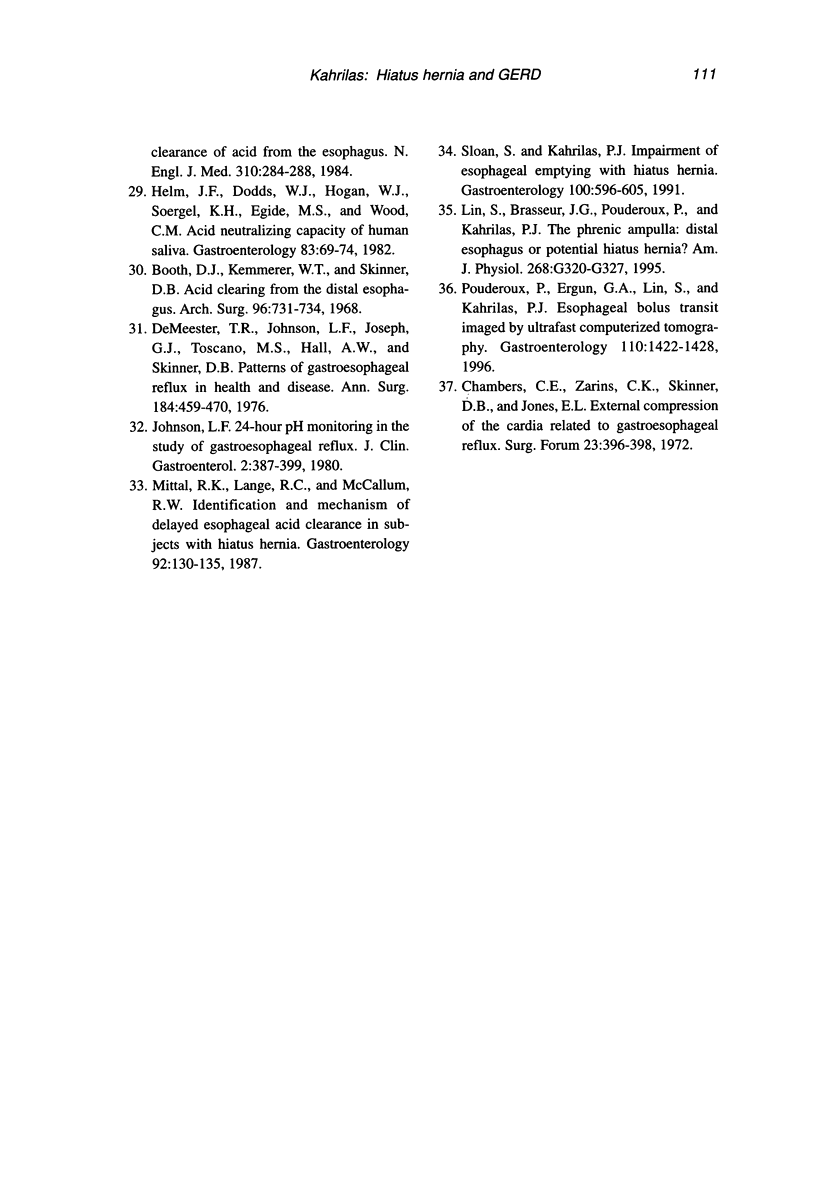
Selected References
These references are in PubMed. This may not be the complete list of references from this article.
- Barham C. P., Gotley D. C., Mills A., Alderson D. Precipitating causes of acid reflux episodes in ambulant patients with gastro-oesophageal reflux disease. Gut. 1995 Apr;36(4):505–510. doi: 10.1136/gut.36.4.505. [DOI] [PMC free article] [PubMed] [Google Scholar]
- Booth D. J., Kemmerer W. T., Skinner D. B. Acid clearing from the distal esophagus. Arch Surg. 1968 May;96(5):731–734. doi: 10.1001/archsurg.1968.01330230039006. [DOI] [PubMed] [Google Scholar]
- Boyle J. T., Altschuler S. M., Nixon T. E., Pack A. I., Cohen S. Responses of feline gastroesophageal junction to changes in abdominal pressure. Am J Physiol. 1987 Sep;253(3 Pt 1):G315–G322. doi: 10.1152/ajpgi.1987.253.3.G315. [DOI] [PubMed] [Google Scholar]
- Boyle J. T., Altschuler S. M., Nixon T. E., Tuchman D. N., Pack A. I., Cohen S. Role of the diaphragm in the genesis of lower esophageal sphincter pressure in the cat. Gastroenterology. 1985 Mar;88(3):723–730. doi: 10.1016/0016-5085(85)90143-x. [DOI] [PubMed] [Google Scholar]
- Chambers C. E., Zarins C. K., Skinner D. B., Jones E. L. External compression of the cardia related to gastroesophageal reflux. Surg Forum. 1972;23(0):396–398. [PubMed] [Google Scholar]
- Cohen S., Harris L. D. Does hiatus hernia affect competence of the gastroesophageal sphincter? N Engl J Med. 1971 May 13;284(19):1053–1056. doi: 10.1056/NEJM197105132841902. [DOI] [PubMed] [Google Scholar]
- Demeester T. R., Johnson L. F., Joseph G. J., Toscano M. S., Hall A. W., Skinner D. B. Patterns of gastroesophageal reflux in health and disease. Ann Surg. 1976 Oct;184(4):459–470. doi: 10.1097/00000658-197610000-00009. [DOI] [PMC free article] [PubMed] [Google Scholar]
- Dent J., Dodds W. J., Friedman R. H., Sekiguchi T., Hogan W. J., Arndorfer R. C., Petrie D. J. Mechanism of gastroesophageal reflux in recumbent asymptomatic human subjects. J Clin Invest. 1980 Feb;65(2):256–267. doi: 10.1172/JCI109667. [DOI] [PMC free article] [PubMed] [Google Scholar]
- Dent J., Dodds W. J., Hogan W. J., Toouli J. Factors that influence induction of gastroesophageal reflux in normal human subjects. Dig Dis Sci. 1988 Mar;33(3):270–275. doi: 10.1007/BF01535748. [DOI] [PubMed] [Google Scholar]
- Dodds W. J., Dent J., Hogan W. J., Helm J. F., Hauser R., Patel G. K., Egide M. S. Mechanisms of gastroesophageal reflux in patients with reflux esophagitis. N Engl J Med. 1982 Dec 16;307(25):1547–1552. doi: 10.1056/NEJM198212163072503. [DOI] [PubMed] [Google Scholar]
- Friedland G. W. Progress in radiology: historical review of the changing concepts of lower esophageal anatomy: 430 B.C.--1977. AJR Am J Roentgenol. 1978 Sep;131(3):373–378. doi: 10.2214/ajr.131.3.373. [DOI] [PubMed] [Google Scholar]
- Helm J. F., Dodds W. J., Hogan W. J., Soergel K. H., Egide M. S., Wood C. M. Acid neutralizing capacity of human saliva. Gastroenterology. 1982 Jul;83(1 Pt 1):69–74. [PubMed] [Google Scholar]
- Helm J. F., Dodds W. J., Pelc L. R., Palmer D. W., Hogan W. J., Teeter B. C. Effect of esophageal emptying and saliva on clearance of acid from the esophagus. N Engl J Med. 1984 Feb 2;310(5):284–288. doi: 10.1056/NEJM198402023100503. [DOI] [PubMed] [Google Scholar]
- Hirschowitz B. I. A critical analysis, with appropriate controls, of gastric acid and pepsin secretion in clinical esophagitis. Gastroenterology. 1991 Nov;101(5):1149–1158. doi: 10.1016/0016-5085(91)90062-p. [DOI] [PubMed] [Google Scholar]
- Johnson L. F. 24-hour pH monitoring in the study of gastroesophageal reflux. J Clin Gastroenterol. 1980 Dec;2(4):387–399. doi: 10.1097/00004836-198012000-00016. [DOI] [PubMed] [Google Scholar]
- Kahrilas P. J., Dodds W. J., Dent J., Wyman J. B., Hogan W. J., Arndorfer R. C. Upper esophageal sphincter function during belching. Gastroenterology. 1986 Jul;91(1):133–140. doi: 10.1016/0016-5085(86)90449-x. [DOI] [PubMed] [Google Scholar]
- Kahrilas P. J., Dodds W. J., Hogan W. J., Kern M., Arndorfer R. C., Reece A. Esophageal peristaltic dysfunction in peptic esophagitis. Gastroenterology. 1986 Oct;91(4):897–904. doi: 10.1016/0016-5085(86)90692-x. [DOI] [PubMed] [Google Scholar]
- Kahrilas P. J., Gupta R. R. Mechanisms of acid reflux associated with cigarette smoking. Gut. 1990 Jan;31(1):4–10. doi: 10.1136/gut.31.1.4. [DOI] [PMC free article] [PubMed] [Google Scholar]
- Kahrilas P. J., Wu S., Lin S., Pouderoux P. Attenuation of esophageal shortening during peristalsis with hiatus hernia. Gastroenterology. 1995 Dec;109(6):1818–1825. doi: 10.1016/0016-5085(95)90748-3. [DOI] [PubMed] [Google Scholar]
- Klein W. A., Parkman H. P., Dempsey D. T., Fisher R. S. Sphincterlike thoracoabdominal high pressure zone after esophagogastrectomy. Gastroenterology. 1993 Nov;105(5):1362–1369. doi: 10.1016/0016-5085(93)90140-8. [DOI] [PubMed] [Google Scholar]
- Liebermann-Meffert D., Allgöwer M., Schmid P., Blum A. L. Muscular equivalent of the lower esophageal sphincter. Gastroenterology. 1979 Jan;76(1):31–38. [PubMed] [Google Scholar]
- Lin S., Brasseur J. G., Pouderoux P., Kahrilas P. J. The phrenic ampulla: distal esophagus or potential hiatal hernia? Am J Physiol. 1995 Feb;268(2 Pt 1):G320–G327. doi: 10.1152/ajpgi.1995.268.2.G320. [DOI] [PubMed] [Google Scholar]
- MICHELSON E., SIEGEL C. I. THE ROLE OF THE PHRENICO-ESOPHAGEAL LIGAMENT IN THE LOWER ESOPHAGEAL SPHINCTER. Surg Gynecol Obstet. 1964 Jun;118:1291–1294. [PubMed] [Google Scholar]
- Martin C. J., Dodds W. J., Liem H. H., Dantas R. O., layman R. D., Dent J. Diaphragmatic contribution to gastroesophageal competence and reflux in dogs. Am J Physiol. 1992 Oct;263(4 Pt 1):G551–G557. doi: 10.1152/ajpgi.1992.263.4.G551. [DOI] [PubMed] [Google Scholar]
- Martin C. J., Patrikios J., Dent J. Abolition of gas reflux and transient lower esophageal sphincter relaxation by vagal blockade in the dog. Gastroenterology. 1986 Oct;91(4):890–896. doi: 10.1016/0016-5085(86)90691-8. [DOI] [PubMed] [Google Scholar]
- Mittal R. K., Chiareli C., Liu J., Shaker R. Characteristics of lower esophageal sphincter relaxation induced by pharyngeal stimulation with minute amounts of water. Gastroenterology. 1996 Aug;111(2):378–384. doi: 10.1053/gast.1996.v111.pm8690202. [DOI] [PubMed] [Google Scholar]
- Mittal R. K., Fisher M. J. Electrical and mechanical inhibition of the crural diaphragm during transient relaxation of the lower esophageal sphincter. Gastroenterology. 1990 Nov;99(5):1265–1268. doi: 10.1016/0016-5085(90)91148-y. [DOI] [PubMed] [Google Scholar]
- Mittal R. K., Holloway R. H., Penagini R., Blackshaw L. A., Dent J. Transient lower esophageal sphincter relaxation. Gastroenterology. 1995 Aug;109(2):601–610. doi: 10.1016/0016-5085(95)90351-8. [DOI] [PubMed] [Google Scholar]
- Mittal R. K., Lange R. C., McCallum R. W. Identification and mechanism of delayed esophageal acid clearance in subjects with hiatus hernia. Gastroenterology. 1987 Jan;92(1):130–135. doi: 10.1016/0016-5085(87)90849-3. [DOI] [PubMed] [Google Scholar]
- Mittal R. K., Rochester D. F., McCallum R. W. Electrical and mechanical activity in the human lower esophageal sphincter during diaphragmatic contraction. J Clin Invest. 1988 Apr;81(4):1182–1189. doi: 10.1172/JCI113433. [DOI] [PMC free article] [PubMed] [Google Scholar]
- Mittal R. K., Rochester D. F., McCallum R. W. Sphincteric action of the diaphragm during a relaxed lower esophageal sphincter in humans. Am J Physiol. 1989 Jan;256(1 Pt 1):G139–G144. doi: 10.1152/ajpgi.1989.256.1.G139. [DOI] [PubMed] [Google Scholar]
- Pouderoux P., Ergun G. A., Lin S., Kahrilas P. J. Esophageal bolus transit imaged by ultrafast computerized tomography. Gastroenterology. 1996 May;110(5):1422–1428. doi: 10.1053/gast.1996.v110.pm8613047. [DOI] [PubMed] [Google Scholar]
- Sloan S., Kahrilas P. J. Impairment of esophageal emptying with hiatal hernia. Gastroenterology. 1991 Mar;100(3):596–605. doi: 10.1016/0016-5085(91)80003-r. [DOI] [PubMed] [Google Scholar]
- Sloan S., Rademaker A. W., Kahrilas P. J. Determinants of gastroesophageal junction incompetence: hiatal hernia, lower esophageal sphincter, or both? Ann Intern Med. 1992 Dec 15;117(12):977–982. doi: 10.7326/0003-4819-117-12-977. [DOI] [PubMed] [Google Scholar]
- Stanciu C., Bennett J. R. Oesophageal acid clearing: one factor in the production of reflux oesophagitis. Gut. 1974 Nov;15(11):852–857. doi: 10.1136/gut.15.11.852. [DOI] [PMC free article] [PubMed] [Google Scholar]
- Wyman J. B., Dent J., Heddle R., Dodds W. J., Toouli J., Downton J. Control of belching by the lower oesophageal sphincter. Gut. 1990 Jun;31(6):639–646. doi: 10.1136/gut.31.6.639. [DOI] [PMC free article] [PubMed] [Google Scholar]


